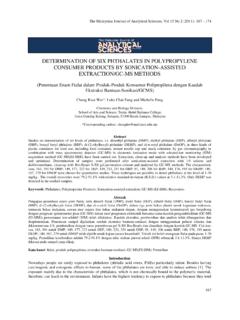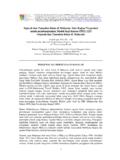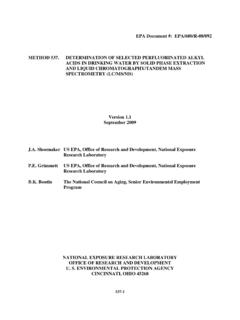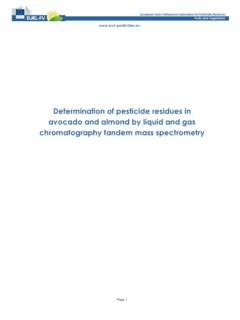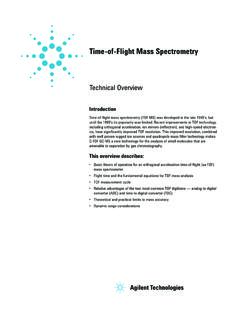Transcription of DETERMINATION OF POLYCYCLIC AROMATIC …
1 The Malaysian Journal of Analytical Sciences Vol. 12 No. 1 (2008) 16 DETERMINATION OF POLYCYCLIC AROMATIC HYDROCARBONS IN PALM OIL MILL EFFLUENT BY SOXHLET EXTRACTION AND GAS CHROMATOGRAPHY-FLAME IONIZATION DETECTION Nor Fairolzukry Ahmad Rasdy, M. Marsin Sanagi,* Wan Aini Wan Ibrahim, Ahmedy Abu Naim Department of Chemistry, Faculty of Science, Universiti Teknologi Malaysia 81310 UTM Skudai, Johor, Malaysia *E-mail: Keywords: POLYCYCLIC AROMATIC hydrocarbons, GC-FID, Soxhlet extraction Abstract A method has been developed for the DETERMINATION of POLYCYCLIC AROMATIC hydrocarbons (PAHs) from palm oil mill effluent based on gas chromatography-flame ionization detection. Extraction of spiked PAHs (napthalene, fluorene phenanthrene, fluoranthene and pyrene) in palm oil waste was carried out by Soxhlet extraction using hexane-dichloromethane (60:40 v/v) as the solvent.
2 Excellent separations were achieved using temperature programmed GC on Ultra-1 fused-silica capillary column (30 m 250 m ID), carrier gas helium at a flow rate of 1 mL/min. Introduction POLYCYCLIC AROMATIC hydrocarbons (PAHs) are a class of diverse organic compounds containing two or more fused AROMATIC rings of the carbon and hydrocarbon atoms. They are ubiquitous pollutants formed from the combustion of fossil fuels and are always found as a mixture of individual compounds. PAHs as one of the typical persistent organic compounds (POPs) featured in regional and global cycling. PAHs are emitted mainly into the atmosphere and have been detected at long distances from their source. Because of their low vapor pressures, compounds with five or more AROMATIC rings exist mainly adsorbed to airborne particulate matter, such as fly ash and soot [1].
3 The analysis of these PAHs is of great interest because of their toxicity and persistence in the environment. PAHs are adsorbed strongly to the organic fraction of sediments and soils [2]. Therefore, it can be concluded that sediments and soils are usually considered as the main sinks for PAHs in the environment. POLYCYCLIC AROMATIC hydrocarbons (PAHs) are reported to have mutagenic and/or carcinogenic effects. The ability of PAHs to induce cancer has been documented by epidemiological studies of worker in coal tar, creosote, coal gas, coke, and cutting oil industries [1]. Some analogues of these compounds, such as POLYCYCLIC AROMATIC sulfur heterocycles (PASHs), are also potentially mutagenic and carcinogenic. But, although they have a high bioaccumulation and have been found in some water and sediment samples, they have not been studied as extensively as PAHs.
4 PAHs are routinely analyzed by one-dimensional capillary gas chromatography (GC). Normally, high-resolution mass spectrometry can detect the PAHs in sample [3]. This study will discuss more about analysis of PAHs using one-dimensional gas chromatography-flame ionization detection (GC-FID). This is significant for screening PAHs present in environmental sample before further analysis. Experimental Reagents Methanol was obtained from HyperSolv, BDH Laboratory, (England). Acetonitrile, dichloromethane, hexane (all in HPLC grade) were supplied by Fisher Chemicals (USA). The POLYCYCLIC AROMATIC hydrocarbons (napthalene, fluorene, phenanthrene, fluoranthene and pyrene) were obtained from Fluka Chemika, Sigma-Aldrich Chemic, Steinheim, (Switzerland). The molecular weight and molecular structures of the PAHs are shown in Table 1.
5 Double-distilled deionized water of at least 18 M was purified by Nano ultra pure water system (Barnstead, USA). The Malaysian Journal of Analytical Sciences Vol. 12 No. 1 (2008) 17 Table 1: Properties of four POLYCYCLIC AROMATIC hydrocarbons (PAHs) Compound Formula Structure Molecular Weight 3D Molecular Structure Napthalene 128 C10H8 Fluorene 166 C13H10 Phenanthrene 178 C14H10 Fluoranthene 202 C16H10 Pyrene 202 C16H10 Chromatographic conditions The GC-FID system consist of a Hewlett Packard Model 6890GC gas chromatography (GC) equipped with a flame ionization detector (FID) and a data processor (USA). The gas chromatographic column used was Ultra-1 932530, a non-polar, fused-silica capillary column (30 m length 250 m inner diameter m film thickness) (USA).
6 Helium gas was used as the carrier gas at a flow rate of 1 mL/min at a pressure of 75 kpa. The injector temperature was set at 250 C and the detector temperature at 310 C. The temperature program used was; 2 minute s hold time at 250 C, a ramp to 130 C at 30 C/min followed by 3 minutes hold time, a ramp to 240 C at 7 C/min and a final ramp to 285 C at 12 C with an 8 minutes hold time. Procedure The mixture of standard solution was prepared from the 1000 ppm stock solution. The mixed standard solution was prepared to produce the calibration graph of each PAHs to determine the limit of detection. The prepared mixture solution (80, 60, 40, 20, 10 ppm) was injected in triplicate onto the column. The Malaysian Journal of Analytical Sciences Vol. 12 No. 1 (2008) 18 About 10 g of dried palm oil mill effluent sample, thoroughly mixed with anhydrous sodium sulphate (10 g) was Soxhlet extracted with dichloromethane (200 mL) for 6 hours.
7 The solvent was concentrated to 5 mL in a rotary evaporator under reduced pressure. M potassium hydroxide (100 mL) in methanol was added and the mixture was refluxed for 4 hours in a water bath at 80 C. After cooling, deionized water (20 mL) was added and extraction was performed with hexane (3 50 mL). The combined organic extracts were dried over anhydrous sodium sulphate ( g). The decanted extract was evaporated at 40 C in a rotary evaporator under reduced pressure to near dryness, dissolved in isooctane (1 mL) for silica clean-up. The glass column ( cm ) was slurry packed with silica gel (10 g) in dichloromethane and a top layer of anhydrous sodium sulphate ( g). The column was rinsed with hexane (40 mL) before use. The extract was transferred on to the column and sequentially eluted with hexane (25 mL) and hexane-dichloromethane, 60:40 (30 mL) to give fractions enriched in alkanes and PAHs, respectively.
8 The second eluate was evaporated under reduced pressure to near dryness and replaced with acetonitrile (1 mL) before injection can be made. After cleaning up the sample, 1 L was injected into GC-FID column. The temperature program used was exactly same with the temperature used for standard solution described above. For detection, peaks interfere were compared to the standard and from peak area, recovery value was calculated for spiked sample. Results and Discussion PAHs peak was identified in the mixture standard solution based on their retention time. All of the PAHs were eluted within 25 minutes. Based on the chromatograms obtained (Figure 1), it was noted that the elution orders for the five PAHs on Ultra-1 column were strongly in order of increasing molecular weight. Napthalene ( min) with the lowest molecular weight was first eluted across the column followed by fluorene ( min), phenanthrene ( min), fluoranthene ( min) and pyrene ( min).
9 Even fluoranthene and pyrene with the same molecular weight value can be separated accordingly. The chromatograms were very clear with no interfering peaks appearing in the areas of interest. In order to examine the sensitivity of gas chromatography system, the limits of detection for PAHs are investigated. Theoretical limits of detection (LOD) were determined taking the usual definition, which that gives a peak with a height three times the background noise level. The calibration graph obtained was used to determine the limit of detection (LOD). A linear calibration graph was produced for each standard PAHs with the correlation coefficient ranging between The value of the correlation coefficient obtained for each calibration graph shows that the correlation between relative peak area and concentration is good.
10 The calibration graph of naphthalene, fluorene, phenanthrene, fluoranthene and pyrene are shown in Figure 2. Table 2, given the regression equation, correlation coefficient and LOD for each PAHs. Figure 1: Chromatogram of PAHs study (100 ppm). Peaks identification: (1) naphthalene, (2) fluorene, (3) phenanthrene, (4) fluoranthene (5) pyrene The Malaysian Journal of Analytical Sciences Vol. 12 No. 1 (2008) 19 Table 2: Limit of detection, regression equations and correlation coefficient of PAHs studied using GC-FID PAHs Regression Equation Correlation Coefficient, r2 LOD in ppm (From calculation) RSD (%) (n = 3) Naphthalene y = + 3 ( ) Fluorene y = + 8 ( ) Phenanthrene y = + 8 ( ) Fluoranthene y = + 5 ( ) Pyrene y = + 5 ( ) The silica gel column clean-up provided all PAHs in second fraction together with alkylbenzenes, but these monoaromatic hydrocarbons did not interfere with GC analysis.
